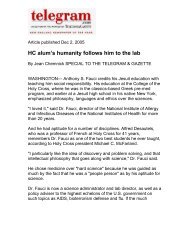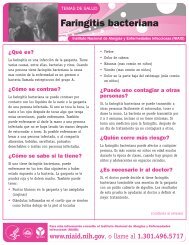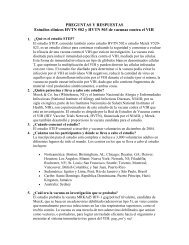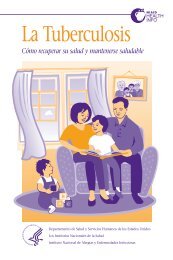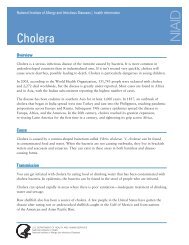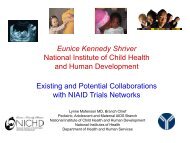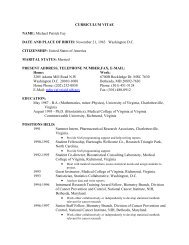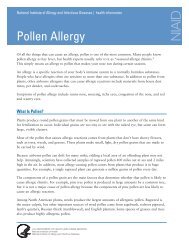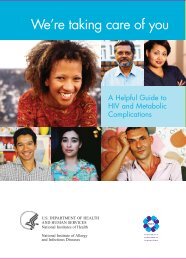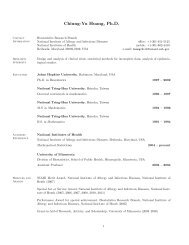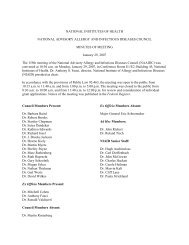Guidelines for the Diagnosis and Management of Food Allergy in the ...
Guidelines for the Diagnosis and Management of Food Allergy in the ...
Guidelines for the Diagnosis and Management of Food Allergy in the ...
You also want an ePaper? Increase the reach of your titles
YUMPU automatically turns print PDFs into web optimized ePapers that Google loves.
MANAGEMENT OF NONACUTE ALLERGIC REACTIONS AND PREVENTION OF FOOD ALLERGY<br />
allergy or that foods that cross-react with <strong>the</strong> major allergenic foods will<br />
cause allergic symptoms. Avoid<strong>in</strong>g foods unnecessarily could put you at risk<br />
<strong>for</strong> <strong>in</strong>adequate nutrition.<br />
Should a child at high risk <strong>for</strong> food allergy be tested prior to <strong>in</strong>troduc<strong>in</strong>g<br />
highly allergenic foods <strong>in</strong>to <strong>the</strong> diet?<br />
The <strong>Guidel<strong>in</strong>es</strong> state that <strong>the</strong>re is not enough evidence to recommend rout<strong>in</strong>e<br />
food allergy test<strong>in</strong>g be<strong>for</strong>e <strong>in</strong>troduc<strong>in</strong>g highly allergenic foods (such as milk,<br />
egg, <strong>and</strong> peanut) to children who are at a high risk <strong>of</strong> react<strong>in</strong>g to <strong>the</strong>se foods.<br />
Children at high risk are those who already have severe allergic disease or a<br />
family history <strong>of</strong> food allergy.<br />
Should a child with no preexist<strong>in</strong>g severe allergic disease <strong>and</strong> no family<br />
history <strong>of</strong> food allergy be tested prior to <strong>in</strong>troduc<strong>in</strong>g highly allergenic foods<br />
<strong>in</strong>to <strong>the</strong> diet?<br />
Guidel<strong>in</strong>e 34 suggests that a child with no preexist<strong>in</strong>g severe allergic disease<br />
<strong>and</strong> no family history <strong>of</strong> food allergy should not be tested <strong>for</strong> food allergy<br />
be<strong>for</strong>e highly allergenic foods are <strong>in</strong>troduced <strong>in</strong>to <strong>the</strong> diet.<br />
Why not? There is <strong>in</strong>suffcient evidence to suggest any beneft to test<strong>in</strong>g <strong>for</strong><br />
food allergy <strong>in</strong> children who have no symptoms or risk factors.<br />
Should a child with eczema be tested <strong>for</strong> food allergy?<br />
Guidel<strong>in</strong>e 35 suggests that a healthcare pr<strong>of</strong>essional should consider evaluat<strong>in</strong>g<br />
a child <strong>for</strong> milk, egg, peanut, wheat, <strong>and</strong> soy allergy if <strong>the</strong> child is younger<br />
than 5 years old <strong>and</strong> has eczema that does not go away with treatment, or has<br />
eczema <strong>and</strong> a history <strong>of</strong> allergic reactions to a specifc food.<br />
What else you should know: Children with moderate to severe eczema are<br />
at risk <strong>for</strong> develop<strong>in</strong>g food allergy, especially allergy to milk, egg, <strong>and</strong> peanut.<br />
These children may beneft from a food allergy evaluation.<br />
Can food allergy be prevented?<br />
Guidel<strong>in</strong>e 36 recommends that a mo<strong>the</strong>r not restrict her diet dur<strong>in</strong>g<br />
pregnancy or when breastfeed<strong>in</strong>g as a way to prevent food allergy from<br />
develop<strong>in</strong>g <strong>in</strong> her child.<br />
NIAID I SUMMARY FOR PATIENTS, FAMILIES, AND CAREGIVERS<br />
23



